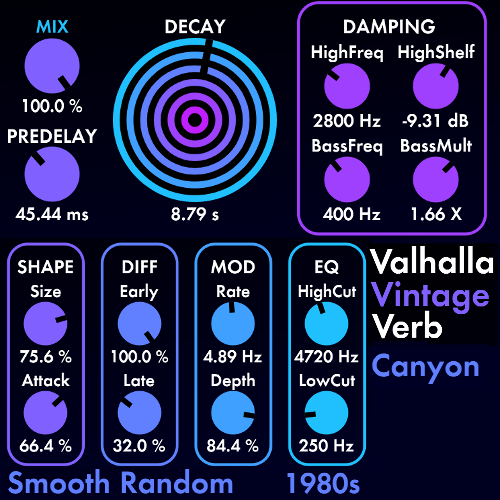Summary: Great reverb, only $50, buy it now

Valhalla Vintage Verb
November 13, 2015
Once upon a time, I spent four figures to get a Lexicon PCM-90 reverb. While not quite a 480L, it was very close and had a far thicker sound than the Roland SRV2000 I was using up to that point. Its sound was not perfect: Long tails sounded thin with obvious cycled modulation in them. But, it sound much better than pretty much anything else available at the time, so I recorded a lot of great songs with it.
Recently, the PCM-90 has been making a high-pitched whine. Online research indicates that this could mean the power supply is broken, suppling too much power to components, which can fry the unit if ignored. So, sadly, I put the PCM90 in a closet until I can get it checked out. Which left me without a really good reverb for my music.
Sean Costello is someone who I bumped in to online half a decade ago. What impressed me was his passion and knowledge of digital reverberation. He was holding his own against Michael Carnes, Lexicon’s then senior reverb designer after David Griesinger left the throne. I knew, based on his writings and obvious knowledge of the subject, that this was someone who could make a great reverb algorithm.
So, with my PCM90 on the blink, I set up with my computer with Hermann Seib’s excellent free VST host program and got the trial versions of Costello’s Valhalla Room and Valhalla Vintage Verb. They sound great, better than my Lexicon PCM90. It took me under an hour to decide to buy both.
About the Valhalla Vintage Verb
The Valhalla Vintage Verb (VVV) is mostly modeled from the early Lexicon reverb units. Unlike the Lexicon units, one can control both the amount and speed of modulation applied to the reverb tail. The Valhalla Vintage Verb originally came with nine algorithms; one example of the excellent customer service that Sean provides is that he added, for free, six more algorithms, increasing the total to 15.
All of the algorithms have the same set of parameters:
- Mix
- Predelay
- Decay (Reverb time or “RT60”). This can be anything to 0.2 to 70 seconds long.
- Hi EQ: Frequency and shelf (how much to reduce high frequencies above a user-selected frequency)
- Bass reverb time: Cross over frequency, and how much to multiply the RT60 time by to get the low-frequency reverb time.
- Shape: Size and “Attack”. Attack is akin to the “spread” and “shape” parameters modern Lexicon reverbs have, and determines how quickly the initial reverberation builds up. Higher values result in a slower build-up.
- Diffusion: Both early and late diffusion can be adjusted.
- Modulation: The depth and rate of the modulation applied to the reverb’s tail can be adjusted.
- EQ: A simple two band EQ, where the high frequency and low frequency cut off can be varied.
- Color: Detemines whether we emulate a 1970s digital reverb, a 1980s digital reverb, or sound fully modern.
- “Mode” determines the algorithm used.
Programming the Vintage Verb
VVV gives the user a lot of flexibility, including some rope to hang oneself with. It’s possible to create some reverbs which sound rattly or bad; it’s also possible to create reverbs which sound really really good. For example, the “smooth random” algorithm with a long tail and high diffusion can sound metallic with some sustained string sounds; this can be eliminated by lowering the diffusion and increasing the attack — but that results in a reverberation which will sound like beads shaking in a can with short percussive sounds.
A small size can result in some unpleasant ringing in long reverb tails; those can be reduced by increasing the modulation depth and adjusting the rate, or by increasing the size some. Then again, having a small size works really nicely with short reverb tails and percussive sounds.
High diffusion is better for percussive and short sounds; low diffusion can reduce the metallic sound one would otherwise get with vocals, strings, or other sustained sounds.
For users who do not have the time to understand how the parameters affect a sound, a number of presets for different sound sources are provided; presets are made by Sean and Don Gunn who worked with him. In addition, it’s possible to save one’s own sounds, either by saving the sound to a file (at which point it is visible when selecting presets again), or by copying the sound parameters to and from the clipboard.
The Valhalla Vintage Verb sound
The sound of this reverb is fantasic; it sounds better than my old PCM90. It also is really light on CPU. I was so pleased with the sound, I set up an older laptop in my recording studio with a Focusrite Scarlett 2i2 interface to make the laptop a dedicated reverb processor.
When Sean recently released his Valhalla Plate plugin, I immediately got a copy of it. It’s, typical of Sean, an excellent reverb.
Indeed, one issue Valhalla Vintage Verb has is that it can either sound metallic with sustained sounds or rattly with percussive sounds; the unit has to be programmed to sound best with the source material it gets. This is a characteristic that the 1980s reverbs VVV emulates have. Valhalla Plate does not have this issue; Sean figured out how to quickly increase modal density without the metallic artifacts 1980s reverbs with high diffusion have.
There was a time when plug-on reverbs did not sound as good as dedicated reverb units. With the Valhalla offerings that is no longer the case; now it’s the plugin reverbs which sound better.
Listen to the Valhalla Vintage Verb
- Preset 1: Small Bright Drum Room
- Preset 2: Small Natural Drum Room
- Preset 3: Big Ambience
- Preset 4: Canyon